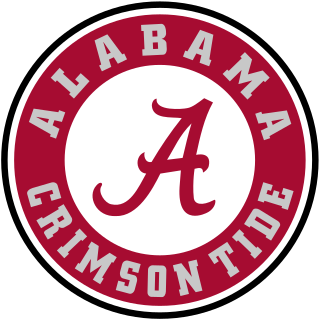Alma Mater
Like many college alma mater songs written around the turn of the 20th century, the Alabama Alma Mater is set to the tune of "Annie Lisle", a ballad written in the 1850s. The words are usually credited as, "Helen Vickers, 1908", although it is not clear whether that was when it was written or if that was her graduating class. The lyrics of the alma mater:
Alabama, listen, Mother, To our vows of love, To thyself and to each other, Faithful friends we’ll prove.
Faithful, loyal, firm and true, Heart bound to heart will beat. Year by year, the ages through Until in Heaven we meet.
College days are swiftly fleeting, Soon we’ll leave their halls Ne’er to join another meeting ‘Neath their hallowed walls.
Faithful, loyal, firm and true Heart bound to heart will beat Year by year, the ages through Until in Heaven we meet.
So, farewell, dear Alma Mater May thy name, we pray, Be rev’renced ever, pure, and stainless As it is today.
Faithful, loyal, firm and true Heart bound to heart will beat Year by year, the ages through Until in Heaven we meet.
"Yea Alabama"
Following Alabama's 1926 Rose Bowl victory over Washington, a contest was held by The Rammer-Jammer, a student newspaper, for the composition of a fight song with a prize of US$75 (adjusted for inflation, US$1240). [7] Several entries were submitted to a panel overseen by the Music Department, and the winning entry, "Yea Alabama", [8] was adopted. The composer, Ethelred Lundy (Epp) Sykes, a student in the School of Engineering, was the editor of The Rammer-Jammer, [9] and played piano in a jazz ensemble, The Capstone Five. He won the university's Pan-Hellenic Cup in 1926 for overall achievement, both academically, athletically, and in student affairs. The song achieved considerable popularity during the 20s and 30s. Sykes went on to become a brigadier general in the U.S. Air Force, and donated the copyright and future royalties to the university in 1947. The Million Dollar Band plays only the chorus at football games such as after touchdowns and field goals.
A Dixieland jazz version of the song appeared on the 1950 Percy Faith album Football Songs (later re-released as Touchdown!) and was played extensively across the state in the 1960s and 1970s as the music bed of radio commercials for sporting goods stores. It was also used as the theme music for The Bear Bryant Show .
The last words of the song, "Roll Tide!", have become the standard cheer, greeting, and farewell among Alabama fans. [10]
The fight song, as played today, has been shortened to begin with the words "Yea Alabama"; [8] however, the original version had a verse that went at the beginning. The original version did not have "Roll Tide, Roll Tide!" at the end, but was added as a chant immediately following the last line of the song.
Amusingly, the song refers to several "traditional" opponents, but two of them are no longer regular opponents. Georgia Tech ("Yellow Jackets") left the SEC in the early 1960s, and has only infrequently filled one of the non-conference game slots, and The University of the South Tigers (also called Sewanee) withdrew from the SEC in 1940, de-emphasized athletics, and no longer competes at the Division I level. Georgia ("Bulldogs"), like Alabama, is a member of the SEC, but the Crimson Tide and Bulldogs are in different divisions and play each other only once every six years, unless the schools meet in the SEC Championship Game. However, Alabama does still annually play the Mississippi State Bulldogs.
The trio (no longer played in most occasions): [11]
Let the Sewanee Tiger scratch,
Let the Yellow Jacket sting,
Let the Georgia Bulldog bite,
Alabama still is right!
And whether win or lose we smile,
For that's Bama's fighting style:
You're Dixie's football pride, Crimson Tide!
The chorus: [12]
Yea, Alabama! Drown ’em Tide!
Every ‘Bama man’s behind you, Hit your stride!
Go teach the Bulldogs to behave,
Send the Yellow Jackets to a watery grave!
And if a man starts to weaken, That’s a shame!
For Bama’s pluck and grit have Writ her name in Crimson flame!
Fight on, fight on, fight on men! Remember the Rose Bowl, we’ll win then!
So roll on to victory, Hit your stride,
You’re Dixie’s football pride, Crimson Tide, Roll Tide, Roll Tide!





